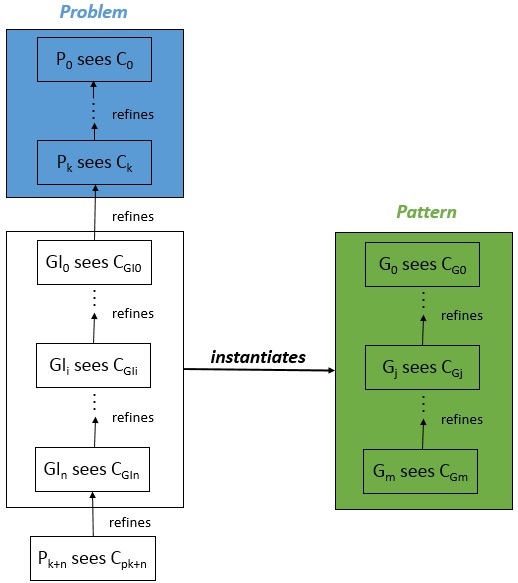Generic Instantiation Plug-in User Guide: Difference between revisions
imported>Asiehsalehi No edit summary |
imported>Asiehsalehi |
||
| (14 intermediate revisions by the same user not shown) | |||
| Line 13: | Line 13: | ||
## In the menu choose ''Help'' -> ''Install New Software...'' | ## In the menu choose ''Help'' -> ''Install New Software...'' | ||
## In the ''Work with'' dropdown list, choose the location URL: Rodin | ## In the ''Work with'' dropdown list, choose the location URL: Rodin | ||
## Select the ''Generic Instantiation | ## Select the ''Generic Instantiation (Soton)'' feature under the ''Composition and Decomposition'' category, then click the check box | ||
## Click ''Next'', after some time, the ''Install Details'' page appears | ## Click ''Next'', after some time, the ''Install Details'' page appears | ||
## Click ''Next'' and accept the license | ## Click ''Next'' and accept the license | ||
| Line 23: | Line 23: | ||
Now you are ready to use the Generic Instantiation Feature plug-in. | Now you are ready to use the Generic Instantiation Feature plug-in. | ||
=== Update === | === Update === | ||
| Line 75: | Line 74: | ||
== Refinement Instantiation == | == Refinement Instantiation == | ||
[[Image:GI_Refinement. | The above example describes generic instantiation applied to individual machines. Although it is already an interesting way of reusing, in a large model it would be more interesting to instantiate a chain of machines, or in other words instantiate a chain of refinement. Considering the below figure, suppose we have a development (problem) containing several refinement levels (<math>P_0</math> ;... ; <math>P_k</math>). The most concrete model <math>P_k</math> matches a generic model (pattern) <math>G_0</math> that is part of a chain of refinement <math>G_0</math> ;... ;<math>G_j</math> ;... ; <math>G_m</math>. By applying generic instantiation we instantiate the pattern <math>G_0</math> according to <math>P_k</math>. That instantiation is a refinement of <math>P_k</math> and it is called <math>GI_0</math>. In addition we can extend the instantiation to one of the refinement layers of the pattern and apply it to the problem development. As an outcome we get a further refinement layer for <math>P_k</math> for free (<math>GI_0</math> corresponds to the instantiation of <math>G_0</math> and <math>GI_n</math> corresponds to the instantiation of <math>G_m</math>). The refinement between <math>GI_0</math> and <math>GI_n</math> does not introduce refinement proof obligations since the proof obligations were already discharged in the pattern chain. This follows from the instantiated machines where it is avoided the re-proof of pattern proof obligations. Afterwards <math>GI_n</math> can be further refined to <math>P_{k+n}</math>. | ||
[[Image:GI_Refinement.jpg|center]] | |||
[[Category:Generic Instantiation Plug-in]] | |||
[[Category:User documentation]] | |||
Latest revision as of 15:20, 4 July 2013
Introduction
The Generic Instantiation (GI) Feature plug-in allows to instantiate and reuse generic developments in other formal developments..
See the Generic Instantiation page for technical details.
Installing and Updating
Setup
The following steps will guide you through the setup process:
- Download Rodin for your platform.
- Extract the downloaded zip file.
- Start Rodin from the folder where you extracted the zip file in the previous step.
- Install the Generic Instantiation Feature plug-in:
- In the menu choose Help -> Install New Software...
- In the Work with dropdown list, choose the location URL: Rodin
- Select the Generic Instantiation (Soton) feature under the Composition and Decomposition category, then click the check box
- Click Next, after some time, the Install Details page appears
- Click Next and accept the license
- Click Finish
- A Security Warning window may appear: click OK
- Restart Rodin as suggested.
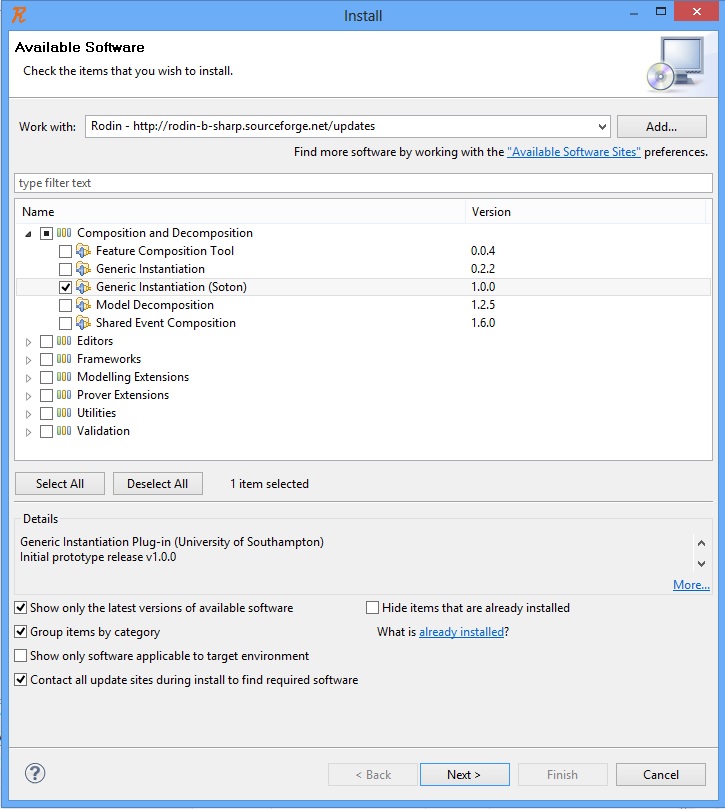
Now you are ready to use the Generic Instantiation Feature plug-in.
Update
The following steps will guide you through the update process:
- In Rodin open the preferences (Window -> Preferences or for Mac: Rodin -> Preferences)
- Find Install/Update -> Automatic Updates
- Select Automatically find new updates and notify me
As soon as Rodin finds a new update it will ask you if you would like to install it.
Release Notes
See the Generic Instantiation Feature Release History.
Instantiating
The example followed here to demonstrate the GI plug-in is from File:Supporting Reuse of Event-B Developments through Generic Instantiation.pdf
Running the Instantiate Action
The Instantiate action launches the instantiation wizard, which will perform the generic instantiation according to the preferences. It is available:
| 1. Either from the toolbar of the Event-B explorer. | 2. Or from the contextual menu, when right-clicking on a machine. |
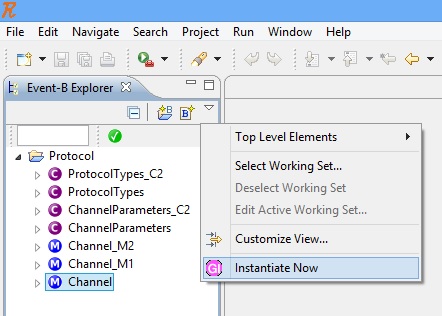 |
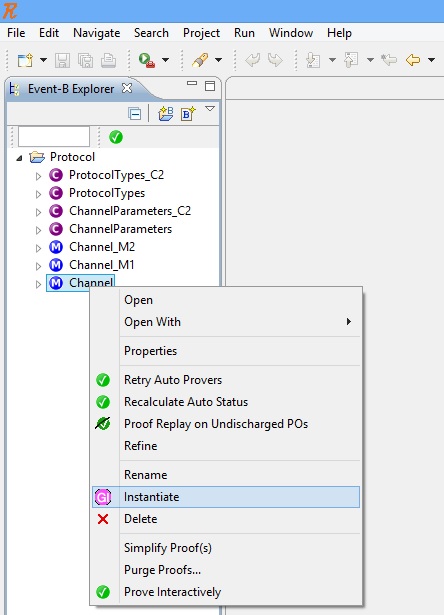 |
Selecting the Pattern Machine and Problem Machine
- Pattern machine is the machine to be instantiated and reuse.
- Problem machine (optional) is the machine to be refined by the instantiating machine. In other words, the instantiating machine is a refinement of the problem machine.
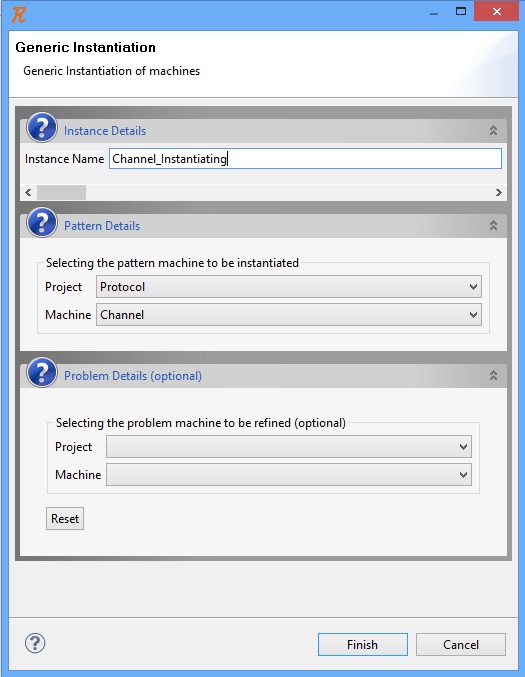
Replacing Sets and Constants
All sets and constants from the pattern context must be replaced by the available sets and constants in the context seen by instantiating machine.
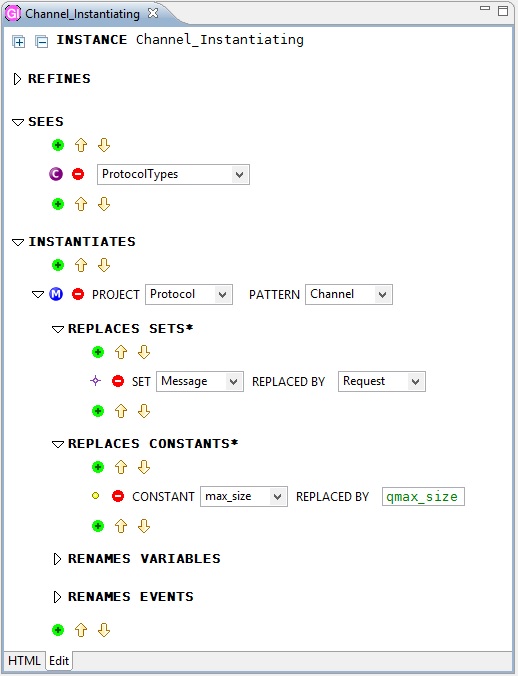
Renaming Variables and Events
Variables and events (also event parameters) can be renamed.
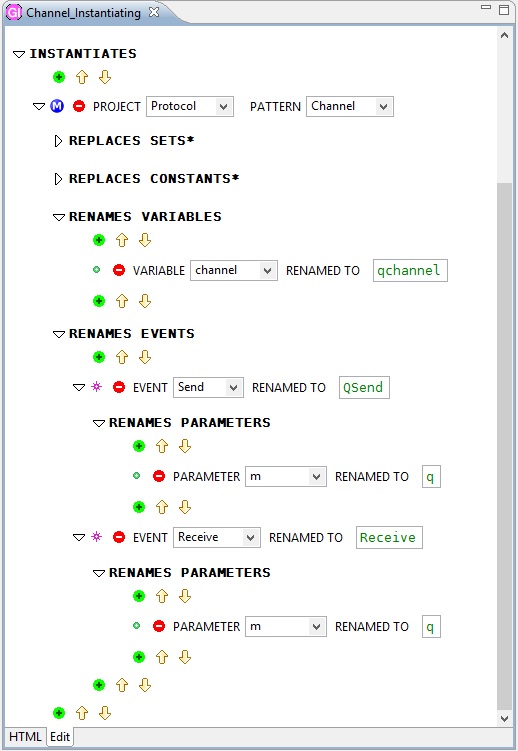
The HTML Editor
The HTML tab editor provides an overall view of the instantiation.
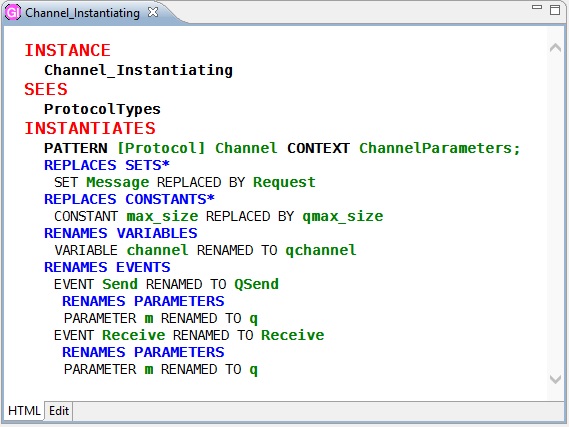
Refinement Instantiation
The above example describes generic instantiation applied to individual machines. Although it is already an interesting way of reusing, in a large model it would be more interesting to instantiate a chain of machines, or in other words instantiate a chain of refinement. Considering the below figure, suppose we have a development (problem) containing several refinement levels ( ;... ;
;... ;  ). The most concrete model
). The most concrete model  matches a generic model (pattern)
matches a generic model (pattern)  that is part of a chain of refinement
that is part of a chain of refinement  ;... ;
;... ; ;... ;
;... ;  . By applying generic instantiation we instantiate the pattern
. By applying generic instantiation we instantiate the pattern  according to
according to  . That instantiation is a refinement of
. That instantiation is a refinement of  and it is called
and it is called  . In addition we can extend the instantiation to one of the refinement layers of the pattern and apply it to the problem development. As an outcome we get a further refinement layer for
. In addition we can extend the instantiation to one of the refinement layers of the pattern and apply it to the problem development. As an outcome we get a further refinement layer for  for free (
for free ( corresponds to the instantiation of
corresponds to the instantiation of  and
and  corresponds to the instantiation of
corresponds to the instantiation of  ). The refinement between
). The refinement between  and
and  does not introduce refinement proof obligations since the proof obligations were already discharged in the pattern chain. This follows from the instantiated machines where it is avoided the re-proof of pattern proof obligations. Afterwards
does not introduce refinement proof obligations since the proof obligations were already discharged in the pattern chain. This follows from the instantiated machines where it is avoided the re-proof of pattern proof obligations. Afterwards  can be further refined to
can be further refined to  .
.
